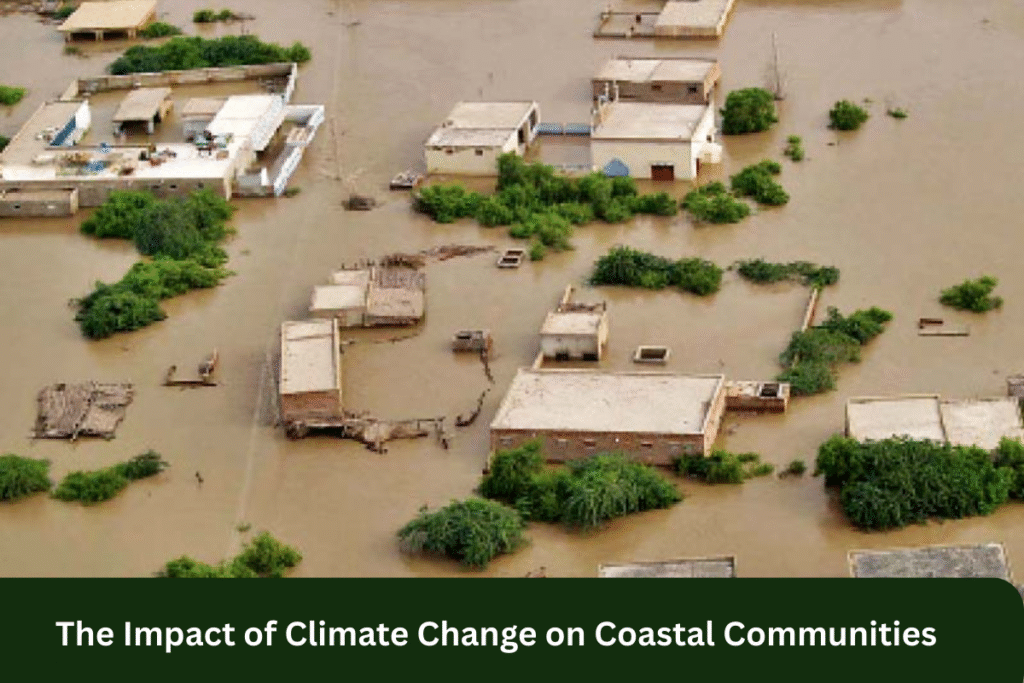
Coastal communities are some of the most vulnerable to the effects of climate change, with rising sea levels, extreme weather events, and shifting ecosystems posing significant risks to their livelihoods, infrastructure, and way of life. These communities, which often rely on coastal resources such as fishing, tourism, and agriculture, are facing increasingly severe challenges as the planet warms. In this article, we explore the impact of climate change on coastal communities, the risks they face, and the strategies needed to build resilience and adapt to the changing environment.
1. Why Are Coastal Communities Vulnerable to Climate Change?
Coastal communities are particularly vulnerable to the impacts of climate change due to their geographic location and dependence on natural resources. The climate crisis amplifies existing threats and exposes these populations to a range of risks that threaten their safety, economy, and environment.
a. Rising Sea Levels
One of the most significant threats to coastal communities is rising sea levels. As global temperatures increase, polar ice melts, and the thermal expansion of seawater leads to higher water levels. According to the Intergovernmental Panel on Climate Change (IPCC), global sea levels have been rising at an accelerated rate, and projections show that by 2100, sea levels could rise by up to 1 meter, threatening low-lying coastal areas.
- Flooding: Rising sea levels increase the frequency and intensity of coastal flooding, especially during high tides or storms.
- Erosion: As sea levels rise, the erosion of beaches, cliffs, and shorelines accelerates, leading to the loss of land and destruction of coastal habitats.
b. Extreme Weather Events
Coastal areas are particularly susceptible to extreme weather events such as hurricanes, cyclones, and typhoons, which are becoming more frequent and intense due to climate change. Warmer ocean temperatures provide more energy for storms, resulting in higher winds, heavier rainfall, and greater storm surges.
- Storm Surges: Extreme weather events can cause storm surges, which push seawater inland, flooding coastal areas and causing significant damage to infrastructure and communities.
- Increased Frequency of Hurricanes and Typhoons: The intensity of tropical storms is increasing, threatening the safety of coastal populations, damaging homes, and disrupting local economies.
c. Loss of Biodiversity
Climate change also impacts coastal ecosystems, such as coral reefs, mangroves, and wetlands, which provide important services to coastal communities.
- Coral Bleaching: Rising ocean temperatures cause coral reefs to bleach and die, disrupting marine biodiversity and fisheries that many coastal communities rely on.
- Loss of Mangroves and Wetlands: Mangroves and wetlands act as natural barriers against storms and flooding. Climate change, however, leads to the loss of these ecosystems, which exacerbates the risks of flooding and erosion.
2. Economic Impacts of Climate Change on Coastal Communities
Coastal communities are economically reliant on industries such as fishing, tourism, and shipping, all of which are increasingly affected by climate change. As these industries face disruptions, the livelihoods of many people in coastal areas are at risk.
a. Fishing and Aquaculture
Many coastal communities depend on fishing for both food security and income. Climate change affects the marine ecosystem, leading to changes in fish populations and the health of aquatic ecosystems. Warmer oceans and changing ocean currents alter migration patterns and the distribution of fish species.
- Decreasing Fish Stocks: Climate-induced changes to ocean temperatures and acidity can harm marine life and disrupt fish populations, reducing catch sizes and fishing yields.
- Aquaculture Risks: Fish farms, particularly those in coastal areas, are vulnerable to temperature fluctuations, disease outbreaks, and storm damage.
b. Tourism and Coastal Infrastructure
Coastal areas are major tourist destinations, attracting millions of visitors each year. Climate change impacts tourism through environmental degradation and extreme weather events.
- Damage to Infrastructure: Storm surges, flooding, and erosion can damage critical infrastructure, such as hotels, resorts, roads, and bridges, leading to costly repairs and reduced tourist activity.
- Decline in Beach Tourism: Rising sea levels and erosion may reduce the appeal of beach destinations, leading to a decline in tourism revenue.
c. Agriculture and Livelihoods
Many coastal communities engage in agriculture, particularly in low-lying areas where fertile soils are found. However, climate change poses risks to agriculture through saltwater intrusion, droughts, and unpredictable rainfall patterns.
- Saltwater Intrusion: Rising sea levels cause saltwater to seep into freshwater sources and agricultural land, affecting crop yields and drinking water availability.
- Unpredictable Weather: Shifting rainfall patterns make it difficult for farmers to predict the growing season, leading to reduced productivity and food insecurity.
3. Social and Health Impacts
In addition to economic challenges, climate change has significant social and health impacts on coastal communities. Vulnerable populations, including low-income families, the elderly, and indigenous groups, are often the most affected.
a. Displacement and Migration
As coastal areas become increasingly uninhabitable due to flooding, storm surges, and loss of land, people are forced to migrate, creating “climate refugees.” Migration can lead to overcrowding in urban areas and strain public services and infrastructure.
- Loss of Home and Livelihood: Many people in coastal areas are forced to leave their homes and livelihoods, leading to social displacement and loss of community ties.
b. Health Risks
Rising temperatures and extreme weather events pose direct health risks to coastal populations.
- Heat-Related Illnesses: Higher temperatures increase the incidence of heat-related illnesses, such as heatstroke and dehydration.
- Infectious Diseases: Warmer oceans and increased rainfall can lead to the spread of waterborne diseases, such as cholera and malaria, as well as vector-borne diseases like dengue and Zika.
4. Strategies for Building Resilience in Coastal Communities
To address the challenges posed by climate change, coastal communities need to develop and implement resilience strategies. These strategies focus on reducing vulnerability, protecting infrastructure, and promoting sustainable livelihoods.
a. Coastal Protection and Ecosystem Restoration
Restoring and protecting natural barriers, such as mangroves, wetlands, and coral reefs, can help mitigate the effects of sea-level rise, storm surges, and coastal erosion. These ecosystems provide critical services like flood protection, carbon sequestration, and habitat for marine life.
b. Climate-Resilient Infrastructure
Building infrastructure that can withstand extreme weather events and rising sea levels is essential for coastal communities. This includes elevated buildings, flood barriers, and resilient roads and bridges that can endure storm surges and flooding.
c. Sustainable Livelihoods and Diversification
Coastal communities should focus on diversifying their economic activities to reduce dependence on climate-vulnerable industries. This may include promoting sustainable tourism, developing renewable energy projects, and implementing climate-resilient farming practices.
d. Community-Based Adaptation and Early Warning Systems
Community-driven adaptation plans, which involve local knowledge and input, are vital in ensuring that solutions are effective and sustainable. Additionally, implementing early warning systems for extreme weather events can help communities prepare and respond in a timely manner.
5. FAQs
1. How does climate change affect coastal communities?
2. What are the economic impacts of climate change on coastal communities?
3. What can coastal communities do to adapt to climate change?
4. How can ecosystems help coastal communities adapt to climate change?
5. What is the role of government and international cooperation in protecting coastal communities?
6. Conclusion
The impact of climate change on coastal communities is profound and multifaceted, affecting their homes, livelihoods, and well-being. However, by implementing resilient adaptation strategies, restoring ecosystems, and focusing on sustainable development, coastal communities can reduce their vulnerability to climate impacts. Addressing these challenges requires a collaborative effort, with governments, businesses, and communities working together to protect vulnerable populations and ensure a sustainable future in the face of climate change.
